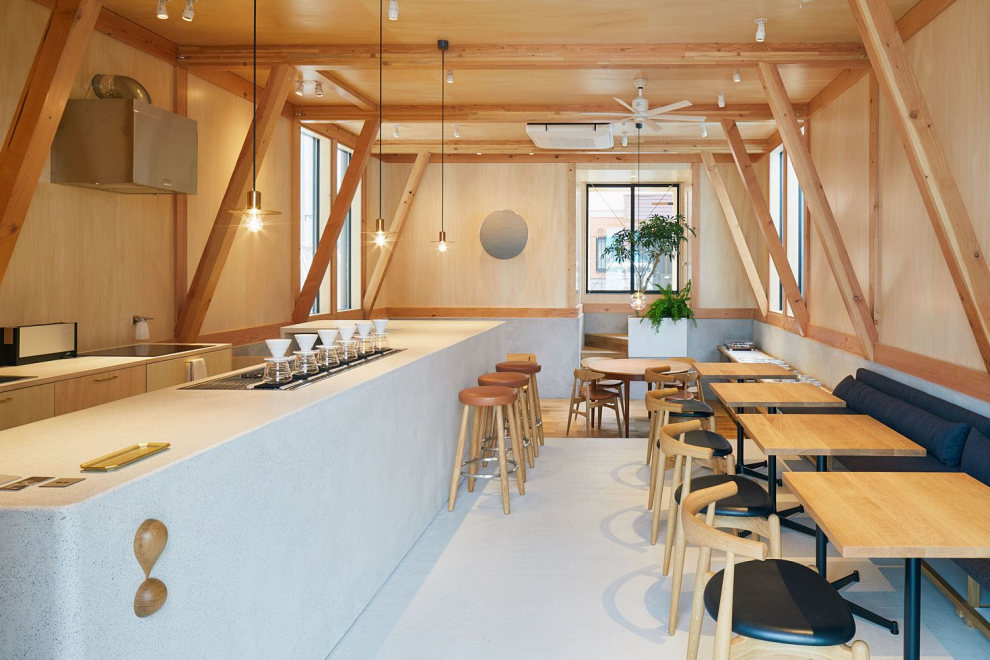Cheap and convenient, the corporate cafeteria has long been a humble — perhaps even drab — fixture of Japan’s workplaces. Now, companies want to make them more than just somewhere workers have their lunch.
Back in the pre-COVID era, it was typical to see cafeterias crowded with hungry employees when the clock hit noon. Yet this scene completely disappeared at many firms in the early stage of the health crisis as people bunkered down at home — another major shift for the nation’s companies that went along with the embrace of remote work.
However, as Japan shakes off its pandemic caution and shifts toward “living with COVID,” more companies are returning to office, and as they do so they are re-imagining the cafeteria as a space where employees can work, eat healthier food and deepen in-house communication, with the canteen all the while showcasing the company’s sustainability and climate credentials.
And in the meantime, tech is expanding the conventional concept of the staff canteen to effectively turn local restaurants into corporate cafeterias for remote workers or companies that don’t own dining facilities.
PANDEMIC BLOW
Like many other corporate catering firms, Tokyo-based Leoc experienced a blow from the pandemic: The company had contracts with more than 800 firms, but a few dozen decided to temporarily close their cafeterias.
This would be “unprecedented” under normal circumstances, says Futoshi Tominaga, a senior executive.
On top of the increasing number of clients suspending cafeteria operations, it was unclear how long the pandemic and stay-at-home trend would last.
In the spring and summer of 2020, “we thought that the impact on our corporate dining service business would be significant,” Tominaga says.
According to Tominaga, the main business model for corporate catering service firms is to simply provide meals to workers of client companies, so if cafeterias are shut down, they are unable to earn revenue.
Leoc fortunately provides dining services to other types of facilities, such as hospitals, nursing homes and kindergartens, so the impact on the overall catering business was somewhat manageable. But the damage was likely devastating for those firms focusing mainly on corporate dining services.
According to health ministry data, the number of corporate dining facilities that served 100 meals or more per dining period or 250 meals or more per day fell to 5,051 in the fiscal year beginning April 2021, down from 5,433 in fiscal 2019.
Shiseido’s renovated cafeteria at its office in Tokyo’s Shiodome district has a common kitchen for employees. The beauty company hopes it and other changes will spur communication among employees. | KAZUAKI NAGATA
Shiseido’s renovated cafeteria at its office in Tokyo’s Shiodome district has a common kitchen for employees. The beauty company hopes it and other changes will spur communication among employees. | KAZUAKI NAGATA
Still, as Japanese society gradually embraces living with COVID, some hope is emerging.
Although service providers were hit hard during the height of the pandemic, the industry appears to be recovering, says Naoki Fujii, head of Shashoku.com, a website focused on news and information on corporate cafeterias.
About a year and half ago, Fujii did not really hear that companies were considering creating or renewing their canteens, but “it seems the tide has turned.”
Tominaga, meanwhile, says most of its client firms that had shuttered their cafeterias have resumed operations.
What’s more, the pandemic has prompted various companies to refine the thinking behind their cafeterias.
Even before the health crisis, cafeterias were starting to become more than just places to eat, but now even more companies are embracing that trend, Tominaga says.
“Requests to renew cafeterias to improve value and convenience have definitely increased,” he says.
Fujii says that dining facilities take up considerable space at many companies, often a whole floor, and it can be wasteful to open them for a few hours just for the purpose of eating.
A number of other factors are also driving the transition, from competition to secure talented workers to advancing the company’s social goals.
“I think it probably has to do with labor shortages as well,” says Fujii. “Some companies want to take advantage of their cafeterias to attract talent.”
Serving better quality meals or hosting food events at the cafeteria is also a way to motivate employees to return to the office, Fujii says, adding that some firms are aiming to provide healthy food for employees who have been working remotely and may have an unbalanced diet.
Futoshi Tominaga, a senior executive at corporate catering firm Leoc, says that even before the pandemic, cafeterias were starting to become more than just places to eat, but now even more companies are embracing that trend. | KAZUAKI NAGATA
Futoshi Tominaga, a senior executive at corporate catering firm Leoc, says that even before the pandemic, cafeterias were starting to become more than just places to eat, but now even more companies are embracing that trend. | KAZUAKI NAGATA
In addition, staff canteens can also be an effective way to promote the U.N.’s sustainable development goals — which Japan Inc. has enthusiastically embraced — with the cafeterias being used to reduce food loss and encourage people to eat environmentally friendly meals.
But one driver stands out above all others: the desire to increase communication, particularly within the company.
CONVERSATION STARTER
One company that focused on strengthening ties between employees and improving the level of satisfaction was tech firm NEC, which renewed its cafeteria at its Tokyo headquarters in October 2021.
Before the renewal, “it was a typical good old corporate cafeteria with a limited variety of menus. The atmosphere was not really cheerful either, as it was mainly a place to eat,” says Takako Hayakawa, who was involved with the renewal project.
As such, NEC employees were not really happy with the previous cafeteria, and the firm had actually been planning the renewal even before the pandemic struck as a part of a larger organizational reform.
Then the health crisis broke out, forcing NEC to accelerate its efforts to drastically reshape its work culture.
As remote work has become regular practice at NEC — each team can now decide how it wants to work — the ratio of employees coming to the Tokyo headquarters has fallen substantially to about 35%.
Considering the change in working style, “we discussed the role of the office again and came to the conclusion that it’s a place for gathering,” says Takeshi Morita, the “culture transformation evangelist” at NEC.
Because meeting with coworkers at the office has taken on new value, “we need to think about how we can maximize that value,” Morita says.
Meals at the renewed cafeteria at NEC’s Tokyo headquarters | KAZUAKI NAGATA
Meals at the renewed cafeteria at NEC’s Tokyo headquarters | KAZUAKI NAGATA
With that in mind, NEC remodeled its cafeteria to make it one of the “innovation hubs” where employees can gather for team meetings or bring outside business partners and clients.
Since it is now more of a workplace, the firm has stopped calling it cafeteria and instead calls it the Field — although with its warm lighting and mostly wooden furnishings, the facility still looks like a modern cafe, and it offers bread baked on-site and handmade soba, udon and ramen. The space is divided into several areas by purpose, such as relaxing, focusing and meeting.
NEC has extended the business hours of the facility — it is open from 7:30 a.m. to 10 p.m. — to allow employees to work there, and provides necessary equipment including portable battery packs and power outlets.
Some NEC workers say that they are happy with the transformation.
“My work floor is more crowded and this place is more open, so I feel that I can better focus on my work here,” says Akihiko Matsubara, who has been working for NEC for about a decade.
He says that because various teams use the new cafeteria for meetings, it helps him know what’s going on in the company, and he is also able to bump into colleagues from other divisions.
“That won’t happen if I stay on my work floor,” Matsubara says.
NEC remodeled its corporate cafeteria at its Tokyo headquarters in October 2021. | KAZUAKI NAGATA
NEC remodeled its corporate cafeteria at its Tokyo headquarters in October 2021. | KAZUAKI NAGATA
Some other major firms are also aiming to facilitate communication by making changes to their dining spaces — for example, Shiseido, Japan’s largest cosmetic firm, remodeled in June 2021.
The renewal was actually planned before the pandemic as part of the renovation of the whole office building in Tokyo’s Shiodome district, as the company was attempting to adopt so-called activity-based working, which lets employees choose different settings depending on the nature of their work.
Like NEC, Shiseido also wanted to turn its cafeteria into a workplace where employees could deepen communication with colleagues, as more employees were to work remotely — Shiseido workers can now choose whether they want to come to the office or work from home.
“We think the seeds of new ideas are found in casual conversation,” so the company wants to provide such opportunities at the canteen, says Mariko Kondo, who is in charge of cafeteria management at Shiseido.
To encourage this communication, the company gives out free pizza every Thursday for those who come there with a group of four people, with the free food limited for the first 10 groups.
The new dining facility, which has a chic black and white interior, features a cafe and bakery section that is open almost all of the day, extending the time that employees can go and work there. On Fridays, it’s open until 8 p.m. and serves alcoholic drinks for those who have finished working.
Also, unlike ordinary corporate cafeterias that only serve meals, Shiseido has set up a common kitchen space where employees can cook together.
Shiseido employees eat lunch at the cafeteria at its office in Tokyo’s Shiodome district last month. | KAZUAKI NAGATA
Shiseido employees eat lunch at the cafeteria at its office in Tokyo’s Shiodome district last month. | KAZUAKI NAGATA
Being a beauty company, the cafeteria space was quite stylish even before the renewal, but its role was mainly serving food for workers during lunch hours rather than deepening communication between colleagues, Kondo says.
Shiseido had actually completely outsourced cafeteria operations prior to the pandemic, but with the renewal Shiseido started directly working with the partner firm to more specifically convey its vision.
Shiseido’s intention is apparently working, as a number of employees seemed to be enjoying meeting their coworkers and chatting with them one day last month.
“Rather than thanking us for making the food better, employees seem to be more grateful that the new cafeteria is providing opportunities to meet with colleagues whom they haven’t seen for a while,” Kondo says.
NEW SPACES
Not all companies have the massive resources of NEC and Shiseido to overhaul their staff cafeterias, but still face the question of how they can satisfy employees and improve communication. And one startup has been pitching its answer: extending the concept of the staff canteen to outside restaurants.
The Biz-Meshi app, developed by Fukuoka-based Gigi, enables companies to subsidize employees’ meals at restaurants that have registered for the service.
Whether they are eating lunch somewhere near the office or home, employees just need their smartphones to receive the subsidy, in effect turning the establishment into a corporate canteen.
The idea for Biz-Meshi stemmed from a Gigi service that allows a person to purchase a digital meal ticket for a restaurant in advance and send it to someone as a gift.
“From the early stage of our business, we were thinking that this project could be used for the digitalization of corporate cafeterias,” says Gigi head Ryosuke Imai, who co-founded the firm in 2018.
Gigi head and co-founder Ryosuke Imai | KAZUAKI NAGATA
Gigi head and co-founder Ryosuke Imai | KAZUAKI NAGATA
The Biz-Meshi service itself was launched in February 2021 at the height of the pandemic, so Gigi thought that demand from companies hoping to provide dining benefits to remote workers would be strong.
But it turned out there were other motivations for adopting the service.
Some companies were under strain because their cafeteria spaces had become a financial burden, as many employees no longer came to the office, Imai says.
“There were companies that actually closed the cafeterias to reduce fixed costs and switched to Biz-Meshi, since it is more flexible,” Imai says.
Also, some firms are using Biz-Meshi as a way to bring their employees back to the office by limiting its use to restaurants near the office, Imai adds.
Currently, the service is used by 40 companies, covering about 5,000 people, and there are about 17,000 registered establishments. Biz-Meshi users can also purchase food at major convenience stores or casual dining restaurants and get reimbursed by scanning the receipt.
Gigi says its client firms range from small, midsize and startup firms to large companies, some of which were hesitant to create their own dining facilities, since they were not sure if enough employees would use them due to the pandemic.
Late last month, Gigi also announced a partnership with Benefit One, a major corporate benefit program service provider. Since Benefit One already has about 16,000 client firms and organizations, the partnership will likely present Gigi with various business opportunities.
Plus, with Japan adopting a policy of living with COVID, people are becoming less afraid of dining outside, so Imai believes that Biz-Meshi can grow further.
Because of the pandemic, “there were times where companies couldn’t really openly recommend that employees eat outside … but such thinking is finally fading,” Imai says.
“The restaurant industry has been suffering due to the pandemic, so we hope that Biz-Meshi can be a message of support for Japan’s food culture, too.”
Source: japan times






































